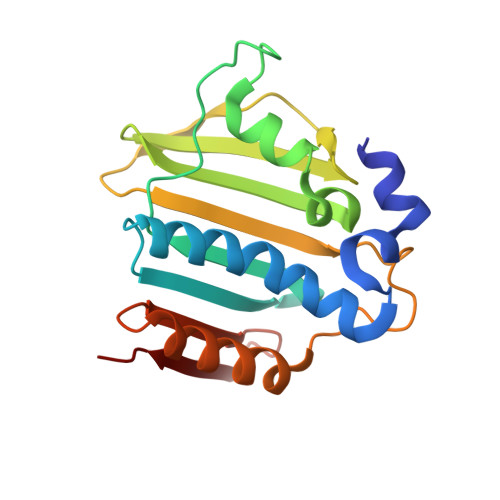Second-generation antibacterial benzimidazole ureas: discovery of a preclinical candidate with reduced metabolic liability.
Grillot, A.L., Tiran, A.L., Shannon, D., Krueger, E., Liao, Y., O'Dowd, H., Tang, Q., Ronkin, S., Wang, T., Waal, N., Li, P., Lauffer, D., Sizensky, E., Tanoury, J., Perola, E., Grossman, T.H., Doyle, T., Hanzelka, B., Jones, S., Dixit, V., Ewing, N., Liao, S., Boucher, B., Jacobs, M., Bennani, Y., Charifson, P.S.(2014) J Med Chem 57: 8792-8816
- PubMed: 25317480
- DOI: https://doi.org/10.1021/jm500563g
- Primary Citation of Related Structures:
4P8O - PubMed Abstract:
Compound 3 is a potent aminobenzimidazole urea with broad-spectrum Gram-positive antibacterial activity resulting from dual inhibition of bacterial gyrase (GyrB) and topoisomerase IV (ParE), and it demonstrates efficacy in rodent models of bacterial infection. Preclinical in vitro and in vivo studies showed that compound 3 covalently labels liver proteins, presumably via formation of a reactive metabolite, and hence presented a potential safety liability. The urea moiety in compound 3 was identified as being potentially responsible for reactive metabolite formation, but its replacement resulted in loss of antibacterial activity and/or oral exposure due to poor physicochemical parameters. To identify second-generation aminobenzimidazole ureas devoid of reactive metabolite formation potential, we implemented a metabolic shift strategy, which focused on shifting metabolism away from the urea moiety by introducing metabolic soft spots elsewhere in the molecule. Aminobenzimidazole urea 34, identified through this strategy, exhibits similar antibacterial activity as that of 3 and did not label liver proteins in vivo, indicating reduced/no potential for reactive metabolite formation.
Organizational Affiliation:
Vertex Pharmaceuticals Incorporated , 50 Northern Avenue, Boston, Massachusetts 02210, United States.















